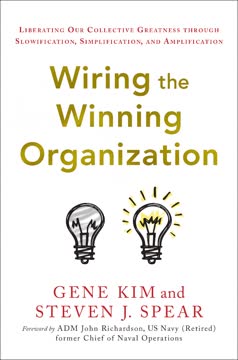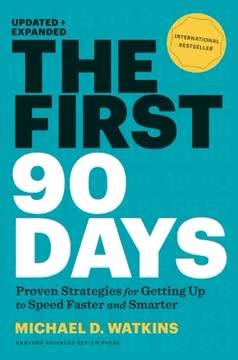Key Takeaways
1. Build a Strong Personal Foundation Before Becoming a CTO
"Being a great CTO isn't just about the first 100 days. It is about what you do before you get there, what you do while you're there, and what you leave behind."
Develop technical expertise and leadership skills. As a CTO, you need a strong foundation in both technical knowledge and leadership abilities. This includes:
- Staying up-to-date with the latest technologies and industry trends
- Honing your problem-solving and critical thinking skills
- Developing emotional intelligence and communication abilities
- Building a strong network of industry professionals
Cultivate a growth mindset. Embrace continuous learning and be open to new experiences. This attitude will help you adapt to the ever-changing landscape of technology and business.
- Seek out mentors and role models in the industry
- Attend conferences and workshops to expand your knowledge
- Experiment with new technologies and methodologies
- Read widely across various disciplines to broaden your perspective
2. Master the Art of Networking and Essential Consulting
"Offer help to people and practice generosity with your time. Remember that your help doesn't necessarily need to translate into dollar signs because it serves the greater good of nurturing your network and career."
Build and nurture relationships. Networking is crucial for CTOs. It helps you stay informed about industry trends, find new opportunities, and build a support system.
- Attend industry events and meetups
- Engage in online communities and forums
- Offer help and advice to others in your field
- Maintain connections through regular check-ins and follow-ups
Provide value through essential consulting. Offering your expertise as a consultant can help you gain valuable experience and build your reputation.
- Start with small projects or pro-bono work to build your portfolio
- Focus on solving specific problems for clients
- Use consulting experiences to refine your skills and expand your knowledge
- Leverage consulting relationships to open doors for future opportunities
3. Nail the Interview Process and Negotiate Effectively
"Value yourself, and in order to value yourself you need to understand the business, its growth, and its revenues."
Prepare thoroughly for interviews. Research the company, its industry, and its challenges. Develop a clear understanding of how you can contribute to the organization's success.
- Review the company's financials, products, and market position
- Prepare specific examples of your past successes and how they relate to the role
- Develop thoughtful questions that demonstrate your interest and insight
Negotiate with confidence. Understand your worth and be prepared to articulate it during salary negotiations.
- Research industry standards for CTO compensation
- Consider the total package, including equity, bonuses, and benefits
- Be willing to walk away from a bad deal
- Focus on creating a win-win scenario for both you and the company
4. Establish Yourself as a Collaborative Partner in the First 100 Days
"You are working together as an ongoing team to solve issues and build a better company. Don't feel like you need all the answers up front."
Build relationships across the organization. In your first 100 days, focus on getting to know your team, other executives, and key stakeholders.
- Schedule one-on-one meetings with team members and executives
- Practice active listening and empathy
- Identify key influencers and decision-makers within the organization
Deliver a quick win. Identify an opportunity to make an immediate impact and demonstrate your value to the organization.
- Look for low-hanging fruit that can be addressed quickly
- Focus on improvements that align with the company's goals
- Communicate your success and its impact on the organization
- Use the quick win to build credibility and trust
5. Learn the Business Goals and Improve Company Dynamics
"You have the ability to bring the best out of your CEO. You are the person who will help him or her fly while staying grounded in reality."
Understand the company's objectives. Dive deep into the organization's goals, challenges, and competitive landscape.
- Review financial statements and key performance indicators
- Analyze the product roadmap and market positioning
- Identify areas where technology can drive growth and efficiency
Improve cross-functional collaboration. Work to break down silos and foster better communication between departments.
- Implement regular cross-functional meetings or workshops
- Encourage knowledge sharing and collaborative problem-solving
- Identify and address bottlenecks in communication or processes
- Promote a culture of transparency and open dialogue
6. Develop and Communicate a Clear Technology Strategy
"What you're doing with this presentation is recognizing that there is a huge flow of information and that a blueprint for moving forward is necessary."
Create a comprehensive technology strategy. Develop a plan that aligns with the company's goals and addresses its challenges.
- Assess the current technology stack and identify areas for improvement
- Define clear objectives and key results (OKRs) for the technology team
- Prioritize initiatives based on business impact and feasibility
Communicate effectively with stakeholders. Present your strategy in a clear, compelling manner that resonates with both technical and non-technical audiences.
- Use visual aids such as flowcharts and diagrams to illustrate complex concepts
- Tailor your message to different stakeholder groups
- Be prepared to address concerns and answer questions
- Regularly update stakeholders on progress and adjustments to the strategy
7. Navigate Challenges and Maintain Trusting Relationships
"Trust is the most fragile thing you will handle in your role. It breaks with a breath. Be careful to maintain it once you have it."
Address conflicts proactively. Don't shy away from difficult conversations or challenging situations.
- Address issues as soon as they arise
- Seek to understand different perspectives before proposing solutions
- Focus on finding win-win outcomes whenever possible
Maintain open lines of communication. Regular, transparent communication is key to building and maintaining trust.
- Implement regular check-ins with your team and other executives
- Be honest about challenges and setbacks
- Follow through on commitments and promises
- Acknowledge and learn from mistakes
8. Embrace Failure and Feedback as Opportunities for Growth
"Failures happen and play a role in your overall performance. If you can predict them and discuss them with the affected people ahead of time, the blow might not be so bad."
Learn from failures. View setbacks as learning opportunities rather than personal shortcomings.
- Conduct thorough post-mortems to understand the root causes of failures
- Implement changes based on lessons learned
- Encourage a culture of experimentation and calculated risk-taking
Seek and act on feedback. Actively solicit feedback from your team, peers, and superiors to continuously improve your performance.
- Implement regular 360-degree feedback sessions
- Be open and receptive to constructive criticism
- Develop action plans based on feedback received
- Demonstrate visible changes in response to feedback to build trust and credibility
Last updated:
Review Summary
CTO Excellence in 100 Days receives high praise from readers, with an average rating of 3.93 out of 5. Reviewers appreciate its practical tips, relatable experiences, and focus on the CTO role. The book is lauded for addressing an under-documented discipline, emphasizing collaboration, listening, and business understanding. Readers find it valuable for both aspiring and seasoned professionals, highlighting its pragmatic approach and comprehensive coverage of technology, leadership, and self-development. Many wish they had access to this book earlier in their careers, as it helps avoid major mistakes and succeed in the C-suite.
Similar Books










Download PDF
Download EPUB
.epub digital book format is ideal for reading ebooks on phones, tablets, and e-readers.




